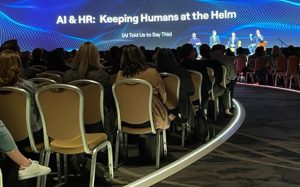 When evaluating a product – from a candy bar to a pair of running shoes—consumers can get a pretty good idea of what the product offers before they buy. But buying into a career opportunity is a bit more ambiguous. And it can be a little scary. If a candidate intends to invest a portion of their career with your company, they’ll need to know if the opportunity is a good fit based on their current skills and aspirations. Will your company provide the challenge to help them grow, the purpose to remain engaged and the support to help them be successful? What will it really feel like to work at your company?
When evaluating a product – from a candy bar to a pair of running shoes—consumers can get a pretty good idea of what the product offers before they buy. But buying into a career opportunity is a bit more ambiguous. And it can be a little scary. If a candidate intends to invest a portion of their career with your company, they’ll need to know if the opportunity is a good fit based on their current skills and aspirations. Will your company provide the challenge to help them grow, the purpose to remain engaged and the support to help them be successful? What will it really feel like to work at your company?
What’s in it for me? (Candidate WIIFM)
The fundamental culture of your company isn’t always apparent through the products or services you offer, yet many companies continue to allow their products to define them as employers. While making outstanding products can go a long way towards expressing what your company does, it doesn’t necessarily convey what differentiates you as an employer.
To that end, many companies have successfully applied their marketing expertise to express their employee value proposition in a way that helps qualified candidates understand why they would want to work there, while being authentic to what an employee will experience once hired. Those candidates who align with your EVP and are compelled by the WIIFM will continue to explore opportunities with your company.
Qualifying your candidates
Large companies with strong brand recognition can get people in seats, but it isn’t enough. Helping candidates to either self-select a good fit or opt out of a misaligned opportunity is equally valuable to your company and the candidate. According to CEB, organizations that brand for influence rather than for appeal enjoy 54% higher-quality applicant pools, 22% higher-quality shortlists, and 9% higher-quality hires.
The four ingredients
So what are the ingredients of a successful talent brand? To borrow from the world of advertising, a talent brand also needs to deliver in four areas.
![]()
- Likeable – Does your brand promise connect with candidates and do they like what they hear? Do they like what they experience through your online and social presence?
- Believable – Is your message authentic and will prospective and current employees find it credible in the workplace? Does it also help set expectations for employee performance or alignment of purpose?
- Ownable – Is your message unique in the space? Does it distinguish your company from the competition, helping you stand apart?
- Memorable – Will candidates be able to recall why your message was compelling when they’re ready to engage?
Simple, right? Though some may be inclined to view this as a simple recipe for talent attraction, a candidate’s consideration doesn’t stop there. Beyond getting your company noticed, it can also help qualify the right candidates, and it sets up a continual employment conversation with active and passive job seekers every time they engage with your company.
Talent branding takes a dedicated effort on the part of your company’s Talent Acquisition team and talent branding partners. So the next time you reach for that candy bar on the store shelf, consider not only the product, but how that brand positions itself as a sweet employment opportunity.
Ready to create a strong employer brand that can help you compete with top talent? Let’s schedule some time to talk today. To get in touch, call Beverly Thomas at 908.399.3308, or email bthomas@bnoinc.com
Reference: CEB – Branding for Influence.
George Jackus is SVP, Creative at BNO, a creative agency.
Follow BNOinc on Facebook, Twitter and LinkedIn, and subscribe to our Thr3i Blog.



